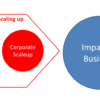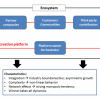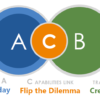Here is a chart, shown by Scott Anthony from Innosight during a worthwile talk on ‘Dual Transformation’ in July this year. It puts in a nutshell what he refers to as the “hardest challenge in business today”: Simultaneously strengthening today’s business while creating tomorrow’s. The chart greatly captures the fact that dual transformation involves three distinct playing fields: Transformation A: Strengthen Today […]

Startup Engagement in Corporate Innovation
Recently, Match-Maker Ventures and Arthur D. Little have released an interesting report, titled “The Age of Collaboration“. The study does a good job in synthesizing the global state of play of corporate-startup collaboration and latest findings on success requirements for its implementation. More and more corporations seek to engage with startups by pursuing corresponding activities across dedicated ecosystems and incorporating them […]

SCALING UP: From Corporate Startup to Innovation Impact
More than three years ago, we noticed a pain point in corporate innovation: How should companies balance the different requirements in searching for tomorrow’s business and in running today’s business? We wrote a well-received article series urging the need for organizational ambidexterity, i.e. implementing dual corporate innovation structures. First important steps have been taken Our […]

Organizational Agility Entails Complementary Innovation
Recently, I’ve come across a couple of posts and articles debating on the question: In order to increase agility, should organizations aim to become more nimble across their existing structures or should they capitalize on separated units/ventures – such as innovation or digital labs – being dedicated to initiate and develop explorative ideas and opportunities? Let’s define agility as […]

Corporate Innovation Ventures: Separation vs. Integration
Probably the most critical structural ingredient for innovation capability is how new ventures – internal as well as external ones – are to be implemented in the organization in order to get validated and scaled. Should a new venture be entirely separated from the core business as stand-alone venture? Should it be integrated into an existing business unit? Or is it […]

The Case for Dual Innovation
The first time I was advocating the idea of a dual innovation approach, here also referred to as organizational ambidexterity, is now more than 5 years ago. At this time it became pretty obvious to me that this concept – academically worn-out but deficiently or not at all put into practice in most organizations – would be of increasing importance […]

A Model for Integrative Innovation Management
In previous posts, I have shared my view on important cornerstones for successful innovation management systems. As pointed out several times, balanced and up-to-date innovation management requires organizational ambidexterity, i.e. the capability to explore novel offerings and capabilities while simultaneously exploiting existing ones. In the following, I would like to summarize and complement these thoughts by suggesting an innovation management model that may help organizations to innovate more […]

Key Innovation Issues for 2016 and Beyond
In the course of this first month of 2016, I was asked a couple of times what my prospects are for the year ahead when it comes to key innovation issues. Hence, I gave it some thought, starting by revisting an earlier reflection: Beginning of 2013, Tim Kastelle and I identified four key issues in innovation management for the time […]

Innovation Requires Dedicated Management
For quite some time, I’ve been advocating the idea that successful and sustainable corporate innovation management systems should be based on the following cornerstones: Organizational ambidexterity: Sustainable innovation management is required to account for organizational ambidexterity, i.e. optimizing existing businesses and developing new businesses have to be driven in parallel. Failing to achieve an individually optimal balance will not lead to company success in the short and long […]

Organizational Models for Breakthrough Innovation
As we have suggested earlier, innovation activities that are radical or disruptive in nature, should be separated from incremental innovation around a company’s established core business. The main reasons are: Required capabilities, structures, approaches, success metrics and culture for radical/disruptive innovation are highly incompatible with those required for incremental innovation. Radical/disruptive innovation activities need full-time resources to get executed properly and time-efficiently. However, separation is a […]
Search
Recent Posts
- Dual Innovation: Ambidexterity 2.0 August 18, 2020
- Future-proof Companies: Combining Agility with Ambidexterity July 16, 2020
- Digital Innovation Units: Setting-Up for Scaling-Up June 27, 2020
- Digital Transformation: Dual Approach to Business Model Innovation June 14, 2020
- Dual Innovation at a Glance November 13, 2019
-
 A Model for Integrative Innovation Management
March 21, 2016
A Model for Integrative Innovation Management
March 21, 2016
-
 Integrative Innovation
February 19, 2013
Integrative Innovation
February 19, 2013
-
 Innovation and Organizational Culture
February 14, 2015
Innovation and Organizational Culture
February 14, 2015
-
 Balancing Innovation via Organizational Ambidexterity
May 29, 2013
Balancing Innovation via Organizational Ambidexterity
May 29, 2013
-
 Innovation and Serendipity
May 23, 2013
Innovation and Serendipity
May 23, 2013
-
 Leveraging New Ventures for Innovation
July 21, 2014
Leveraging New Ventures for Innovation
July 21, 2014
-
 Bad Innovation Systems Beat Good Innovators (Almost) Every Time
March 26, 2017
Bad Innovation Systems Beat Good Innovators (Almost) Every Time
March 26, 2017
-
 The Firm of the Future Will Manage Two Types of Businesses
January 20, 2017
The Firm of the Future Will Manage Two Types of Businesses
January 20, 2017
-
 Integrating Lean Startup and Design Thinking
February 1, 2014
Integrating Lean Startup and Design Thinking
February 1, 2014
-
 Balancing Innovation via Organizational Ambidexterity – Part 2
August 12, 2013
Balancing Innovation via Organizational Ambidexterity – Part 2
August 12, 2013
- Dual innovation (Ambidexterity 2.0) - InnoUpdate: […] Scaling up: The foundation […]...
- Innovation Follows Culture Follows Structure – Innovation Excellence - Reporter Inovation: […] previous ideas tie in with our proposed�...
- Innovation Follows Culture Follows Structure – Innovation Excellence - DLIT: […] preceding thoughts tie in with our propo...
- Innovation Follows Culture Follows Structure – Innovation Excellence |: […] preceding thoughts tie in with our propo...
- Innovation Follows Culture Follows Structure – Innovation Excellence | For Entrepreneurs and online business owners: […] preceding thoughts tie in with our propo...
- Innovation Follows Culture Follows Structure – Innovation Excellence: […] preceding thoughts tie in with our propo...
-
PostBox Communications: These aspects that will drive your digital transfo...
-
Srikanth Ramanujam: Interesting stuff. The intersection seems to be "...
-
Marek Stepan: The strength of the situtational forces was the ma...
- Intrapreneur vs Entrepreneur – Characteristics, Examples and Definitions | Success Unscrambled: […] June 2017, Ralph-Christian Ohr wrote abo...
Recent Tweets
- RT @ralph_ohr: The #DigitalTwin is a core metaverse building block. 🧩 Catch up on the latest insights around the emergent #IndustrialMetav… 2 years ago retweeted via ralph_ohr
- RT @ralph_ohr: Bringing a digital platform to the home heating services market: Lessons from @Thermondo https://t.co/O9XB67831y #innovati… 2 years ago retweeted via ralph_ohr
- RT @ralph_ohr: What are venture studios and how can they help with climate innovation? https://t.co/sy7xA8sg5s @wef #innovation #climate #v… 2 years ago retweeted via ralph_ohr
- RT @ralph_ohr: Exploring the Emotional Landscape of #Innovation https://t.co/EiOKENxLya 2 years ago retweeted via ralph_ohr
- RT @ralph_ohr: The new automotive mandate: Moving from building products to building businesses https://t.co/52Zc3PQU2E #innovation #busine… 2 years ago retweeted via ralph_ohr








